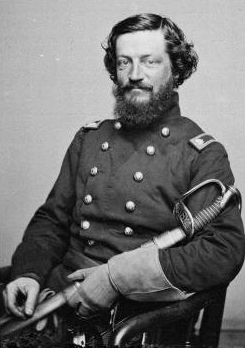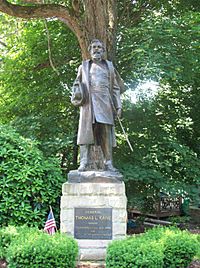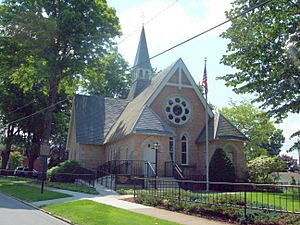Thomas L. Kane facts for kids
Quick facts for kids
Thomas Leiper Kane
|
|
|---|---|

Thomas L. Kane
|
|
| Born | January 27, 1822 Philadelphia, Pennsylvania |
| Died | December 26, 1883 (aged 61) Philadelphia, Pennsylvania |
| Burial site - Kane Memorial Chapel | |
| Allegiance | United States of America Union |
| Service/ |
United States Army Union Army |
| Years of service | 1861–1863 |
| Rank | |
| Commands held | 1st Pennsylvania Rifle Regiment |
| Battles/wars | American Civil War |
| Awards | Statue in the Utah State Capitol |
| Relations |
|
Thomas Leiper Kane (January 27, 1822 – December 26, 1883) was an American lawyer and a strong supporter of ending slavery. He was also a kind person who helped many, and a military officer. He played a big role in helping the Latter-day Saint people move west. During the American Civil War, he served as a colonel and general for the Union Army. He was later given an honorary promotion to major general for his bravery at the Battle of Gettysburg.
After meeting members of the Church of Jesus Christ of Latter-day Saints in 1846, Kane offered his help. They were having problems with the U.S. government as they tried to move west. He helped them get permission to live on land near the Missouri River. Later, he worked to help Utah become a state. He even turned down an offer to be the governor of Utah, suggesting Brigham Young instead. In 1857 and 1858, Kane helped solve a big disagreement between the Latter-day Saints and the U.S. government. He convinced Brigham Young to let the President's choice become governor, which helped stop the Utah War from getting worse.
During the Civil War, Kane formed a Pennsylvania army group called the "Bucktails." He became a lieutenant colonel and later a brigadier general. He bravely gathered important information about Robert E. Lee's plan for the Gettysburg Campaign. Kane and his soldiers won at Gettysburg. But Kane became very sick and had to leave the army. After the war, Kane and his family moved to and helped build the town of Kane, Pennsylvania. He died in 1883 from pneumonia. Both Kane County, Utah, and the Kanesville Tabernacle are named after him. The Kane Historic Preservation Society takes care of the Thomas L. Kane Memorial Chapel in Kane, Pennsylvania. There is also a statue of him in the Utah State Capitol called "Friend of the Mormons."
Contents
Early Life and Fighting Slavery
Kane was born in Philadelphia, Pennsylvania. His father, John K. Kane, was a U.S. district judge. Thomas was described as small and often not feeling well. He studied in the United States, then traveled to Great Britain and France to continue his education and improve his health. In Paris, he became friends with thinkers like Auguste Comte. Police even searched his apartment because they thought he was involved in revolutionary ideas. He learned French well and wrote for French magazines. When he returned home, he studied law and became a lawyer in Pennsylvania in 1846.
As a young man, Kane wanted a career in politics. He tried to get a job in the government of California after the Mexican–American War ended in 1848, but he was not successful. He worked for his father for a short time. Then he got a job as a clerk in a court in eastern Pennsylvania. Kane was an abolitionist, meaning he was against slavery. He was upset when the Compromise of 1850 was passed. This law made it his legal duty to return enslaved people who had escaped to southern areas. He quickly resigned from his job. His father then had him held for a legal disagreement. The U.S. Supreme Court later said this was wrong and he was released. After this, Kane became even more active in the movement to end slavery. He wrote to famous people like Horace Greeley and Ralph Waldo Emerson. He also wrote newspaper articles about ending slavery and about issues facing the Latter-day Saints.
Helping the Mormons
The Mormon Battalion
Kane first met members of the Church of Jesus Christ of Latter-day Saints at a meeting in Philadelphia in May 1846. He offered them his advice and help. They were having problems with the U.S. government and needed help moving to western lands. Jesse C. Little, a leader in the church, was trying to get support for their move west. Kane had good connections through his father. He gave Little letters of recommendation and later joined him in Washington, D.C.. They met with important government officials, including the President, James K. Polk. Because of their talks, the United States agreed to let up to 500 Latter-day Saint men join the army. These men formed the Mormon Battalion and served in the Mexican–American War.
With his father's help, Kane also got permission for the Latter-day Saints, who were like refugees, to live on lands belonging to the Pottawattamie and Omaha Native American tribes along the Missouri River. Kane then traveled to Fort Leavenworth with messages about these land agreements and the army battalion. He found Jesse C. Little at the Latter-day Saint camps on the Missouri River. On July 17, 1846, Kane, church leaders, and an Army Captain met to officially create the Mormon Battalion. Kane met many church leaders and became very popular among the Latter-day Saint people. The main settlement in Iowa for the group, near what is now Council Bluffs, Iowa, was renamed Kanesville to honor his help.
During this time, Kane became very sick. He received good care from an army doctor and church members, which helped him get better. However, he had poor health for the rest of his life.
Utah Territory and Statehood
In March 1850, while people were discussing creating the Utah Territory, Kane gave an important speech. He spoke about the Latter-day Saint religion, their problems with other settlers, and how empty the city of Nauvoo, Illinois was after they left. He also described their journey west. One thousand copies of his speech were printed and given out, mostly to members of Congress and other important leaders. The speech was also printed in several Latter-day Saint newspapers, reaching many more people. Six months later, he defended Brigham Young in eastern newspapers. President Millard Fillmore asked Kane for information about the Mormons. When Utah became a territory on September 9, 1850, Fillmore asked Kane to be the first governor. Kane said no and suggested Brigham Young instead. Throughout the 1850s, Kane continued to support Utah becoming a state and defended the church whenever he could.
Kane married his cousin, Elizabeth Dennistown Wood, on April 21, 1853. Elizabeth Wood Kane later earned a medical degree in 1883. Two of their sons, Evan and William, and their daughter Harriet, became doctors. Their older son Elisha became an engineer and later an arctic explorer.
After Thomas Kane died in 1883, his wife built a home called Anoatok in Kane, Pennsylvania.
Some historians once thought Kane was a secret member of the Latter-day Saint church. However, Kane, his family, and church leaders all said that he never joined the church. Even though he was interested in their beliefs, he never officially joined any church.
The Utah War
In the winter of 1857–1858, Kane made a very difficult trip from the East Coast to Salt Lake City. Once there, he helped stop a conflict between the Latter-day Saints and the U.S. government, known as the Utah War. After becoming President in March 1857, President James Buchanan heard rumors that the Mormons were rebelling. He appointed a new governor for Utah, Alfred Cumming, to replace Brigham Young. Buchanan then sent an army of 2,500 soldiers to Utah. Their orders were to make sure Cumming became governor, even if they had to use force.
President Buchanan did not officially tell Young about the new governor. Rumors spread that the U.S. army planned to attack Utah communities. The Latter-day Saints had already been forced out of several states. They were ready to burn their own settlements and fight to avoid being forced to move again. They prepared for battle, calling up all able-bodied men aged 15 to 60. They also got ready for a fighting retreat to southern Utah. Latter-day Saint patrols found three army supply trains. Members of the Nauvoo Legion attacked and burned these trains. This stopped the U.S. Army at Fort Bridger in Wyoming for the winter of 1857–1858.
Earlier that year, Kane heard about the "misunderstanding" and offered to help. It was a very cold winter. He traveled to Utah using a different name. He went through Panama by train and then took a ship north to southern California. From there, he traveled overland through San Bernardino, California to Salt Lake City, arriving in February 1858. Kane convinced Young to accept Cumming as the new governor and not to fight the federal troops. Kane then went to the army's winter camp at Fort Bridger. He convinced Governor Cumming to travel to Salt Lake City without his army escort. Young and the people of Utah welcomed Cumming kindly. He soon took his new office. The army arrived in Utah a few weeks later and set up camp about 30 miles (48 km) southwest of Salt Lake City. The army left Utah in 1860 because the upcoming American Civil War needed almost all frontier troops.
While in Salt Lake City, Kane learned that his father had died in 1858. He stayed in Utah until May 13. Then he and a Latter-day Saint escort traveled back east to report to President Buchanan.
Friendship with Brigham Young
Kane became a close friend of Brigham Young. He stayed in touch with the church leader for many years. Kane visited Utah several times. He gave Young advice on how to deal with the federal government.
Kane, his wife, and their two younger sons spent the winter of 1872 in Utah. They traveled throughout the territory. They were guests at Young's winter home in St. George, Utah. Kane hoped to improve his failing health there. During the winter, Kane and Young made plans for Latter-day Saint settlements in parts of Arizona and Mexico. Kane also interviewed Young to gather information for a biography he planned to write, but never finished. Young also asked Kane for legal advice about federal charges against him.
Elizabeth Kane wrote letters to her family during her visit to Utah. Her father later published some of these letters in a book called Twelve Mormon Homes. The journal she kept during her winter in St. George was published in 1992. Kane returned to Utah when Young died in 1877. He attended Young's funeral and offered his sympathy to the family and church leaders. He also helped carry out Young's will, which he had prepared. This made sure that church property and personal property were kept separate. Young had held some church properties in his own name because of a law that made it illegal for the church to own property worth more than $50,000. Ownership of these properties was transferred to the next church president, John Taylor.
Civil War Service
By 1858, Thomas Kane's work helping the Mormons mostly ended. When the Civil War began, Kane formed a group of soldiers called the 42nd Pennsylvania Infantry. This group was also known as the 13th Pennsylvania Reserves. He recruited woodsmen and lumbermen from western Pennsylvania. These men were good at living in the woods, finding their own food, and shooting rifles. As the group was forming, one soldier put a deer's tail on his hat. Other men liked it and copied him, so they became known as the "Bucktails." The men built large log rafts and floated down the Susquehanna River to Harrisburg, Pennsylvania. There, they officially joined the army. On June 12, 1861, Charles John Biddle became the colonel, and Kane was the lieutenant colonel. Kane had actually been voted colonel first, but he stepped down and asked for Biddle to be colonel because Biddle had more military experience.
Kane was known for his new ideas about how soldiers should fight. He taught his men "skirmisher tactics." This meant they learned to spread out when under fire. They used whatever cover the ground offered and only shot when they could see their targets. He believed in individual responsibility for his soldiers, which was different from how armies usually thought at the time. He also held target practice, which was a new idea, and trained them in long-range shooting. This made his men excellent sharpshooters.
The Bucktails were part of the Army of the Potomac. When Colonel Biddle left to join Congress, Lieutenant Colonel Kane took command. On December 20, 1861, Kane was hurt while leading a patrol at the Battle of Dranesville. A bullet hit the right side of his face, knocking out some teeth. This caused problems with his eyesight for a long time.
By spring 1862, Kane had partly recovered and returned to the Bucktails. They served in the Shenandoah Valley, fighting against Stonewall Jackson's army. At Harrisonburg, Virginia, Kane and 104 chosen riflemen were sent to help a group of soldiers who were ambushed. On June 6, 1862, Kane met three Confederate groups. He was hit by a bullet that broke the bone below his right knee. His men had to leave him on the field. When he tried to get up after the fighting, a Confederate soldier hit him with a rifle, breaking his breastbone. Kane became unconscious and was captured. He was exchanged for another officer in mid-August. He returned to duty, but he was so weak that another officer had to lead his group. He needed help getting on his horse and had to use crutches to walk. His wound from Harrisonburg kept reopening for the next two years.
Kane was promoted to brigadier general on September 7, 1862. He was given command of a new group of soldiers. He fought at Chancellorsville. On April 28, 1863, his horse fell in the Rapidan River, throwing him into the water. Kane then got pneumonia. He was sent to a hospital in Baltimore, Maryland, and stayed there until June. When he heard that General Robert E. Lee was invading the North again (Lee's Gettysburg Campaign), Kane volunteered to take important information to the commander of the Army of the Potomac, George Gordon Meade. He left his sickbed to join his men. He had a difficult trip by train and buggy. He avoided being captured by enemy soldiers by pretending to be a regular person. He arrived at Gettysburg, Pennsylvania, on the morning of July 2, 1863.
Kane took command of his soldiers again. They were positioned on Culp's Hill, on the right side of the Union line. His men did not fight much on July 2. This was because his division was moved to defend against Confederate attacks on the Union left. However, when his men returned to their defenses on Culp's Hill that night, they found Confederate soldiers there. Kane's commander ordered an attack for early the next morning to get the position back. Before the Union attack could start on July 3, the Confederates attacked first. Kane and his men fought them off. During the battle, Kane became very ill. Another officer had to help him command. Even though his soldiers won, Kane was very weak and never fully recovered his health. He suffered from his face wound, chest problems, and poor eyesight. He officially gave up command the next day. He was then sent to Pittsburgh, Pennsylvania, to oversee the draft office. Since his health did not improve, Kane resigned from the army on November 7, 1863. For his service at Gettysburg, he was given an honorary promotion to major general on March 13, 1865.
Later Life and Death
After the Civil War, Kane and his wife moved to western Pennsylvania. They eventually owned over 100,000 acres (400 km2) of forest land. Oil and gas were later found on this land. Kane helped plan railroad routes in that area. He also found the low mountain pass where the Philadelphia and Erie Railroad crosses the Alleghenies. Kane was involved in starting the community of Kane, Pennsylvania. He was also a director for a railroad company. He had worked as a secretary at the U.S. embassy in Paris in 1842–1843. He was the first president of the Board of State Charities. He was also a member of several important societies, including the American Philosophical Society. He was a Freemason. His later years were spent doing charity work and writing. He died of pneumonia in Philadelphia and is buried in Kane, Pennsylvania.
Legacy and Memorials
Kane County, Utah was named after Thomas L. Kane. The Kanesville Tabernacle in Council Bluffs, Iowa, was also named for him. The Church of Jesus Christ of Latter-day Saints maintains the Thomas L. Kane Memorial Chapel in Kane, Pennsylvania. This is to honor Kane's friendship and help. Kane was a founder of the town and is buried in the chapel. Also, a bronze statue of Thomas L. Kane is in Utah's Capitol Building. It is called "Friend of the Mormons."
See also
 In Spanish: Thomas L. Kane para niños
In Spanish: Thomas L. Kane para niños
- List of American Civil War generals (Union)
- Thomas L. Kane Memorial Chapel



